How to knit beautiful children's socks with knitting needles. Knitted baby socks
Knitted children's socks with patterns - 3 bright models with patterns on the cuff, which you can knit. Sizes - from 26 to 33. Socks are knitted according to similar patterns, from melange yarn with bright stripes on the foot, and different patterns on the cuff. You can choose what you like best: a bunny, a bear cub or a man on a ladder.
Knitted children's socks with a "Bunny" pattern
Size 28-29
- The following yarn and knitting needles are used:
1. Regia (4 threads) 2068 black and white, floss - 50 g
Stocking needles No. 2-3.
- Patterns:
Instructions
Right sock: Cast on 50 stitches (= 13 stitches on needles 1 and 2 and 12 stitches on needles 3 and 4) in color 4 and rib 8 rows. Then go to color 1 and knit the leg with stockinette stitch (at least 44 rows). Then perform heel, foot and toe as described on p. 12 (see instructions at the end of the article), while knitting the heel with color 5, the foot with color 1 and the toe with color 3. On the finished sock, embroider the motif according to the counted pattern with a loop-to-loop stitch * on the outside of the leg. Embroider the muzzle and mustache with a stem stitch, the eyes and nose with knots using black yarn. Embroider the cones unevenly different colors, they can also be crocheted first and then sewn on.
Pattern diagram:
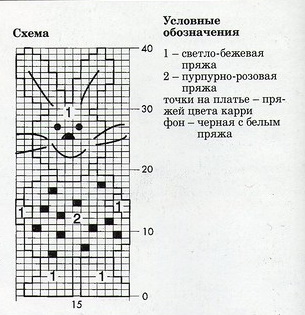
Knitted children's socks with a "Teddy Bear" pattern
Size 26/27
- Yarn and knitting needles:
1. Regia (4 threads) 2068 black and white, floss - 50g
2. Regia (4 threads) 2002 cherry - leftovers
3. Regia (4 threads) 2059 mint color - leftovers
4. Regia (in 4 threads) 2101 curry colors - leftovers
5. Regia (4 threads) 1988 lavender - leftovers
6. Regia (4 threads) 861 light beige - leftovers
7. Regia (4 threads) 2066 black - leftovers
Stocking needles No. 2-3.
- Knitting density:
- Patterns:
Cuff: alternately knit 1 knit stitch, 1 purl loop.
Instructions for knitting children's socks with a pattern
Cast on 48 stitches<= 12 петель на спицу) цветом 2 и провязать резинкой по 4 ряда цветом 2, цветом 4, цветом 5 и цветом 3. Перейти к цвету 1 и для паголенка провязать лицевой гладью 32 ряда. Паголенок закончить лицевой гладью 4 рядами цветом 3 и 4 рядами цветом 1. Вывязать пятку, стопу и мысок, как описывается на с. 12 (см. указания в конце статьи). Пятку связать цветом 1, для стопы выполнить следующие полоски: по 4 ряда цветом 5, цветом 1, цветом 4, цветом 1, цветом 2, цветом 1, цветом 3, цветом 1; повторять от * Мысок вывязать соответствующим цветом.
On the finished socks, embroider the teddy bear according to the counted pattern using a loop-to-loop stitch* on the front side of the leg. Embroider the muzzle and nose with a stem stitch, embroider the eyes with knots in black.
Perform the second sock in the same way.
Pattern diagram

Knitted children's socks with the "Max on the Ladder" pattern
Size - 32-33
- Yarn and knitting needles:
1. Regia (in 4 threads) 2068 black and white, floss - 50 g1
2. Regia (4 turns) 2002 Vivshevy - leftovers
3. Regia (in 4 threads) 2059 mint color - leftovers
4. Regia (in 4 threads) 2101 curry colors - leftovers
5. Regia (4 threads) 1988 lavender - leftovers
6. Regia (in 4 threads >| 2066 black - leftovers
Stocking needles No. 2-3.
- Knitting density
30 stitches x 42 rows in stockinette stitch = 10 x 10 cm.
- Patterns:
Cuff: knit with a scarf pattern (= alternately 1 row with knit stitches, 1 row with purl stitches).
Basic pattern (alternating stripes): knit stitch *7 rows in color 2; 2 rows in color I; 7 rows in color 5; 2 rows in color 1; 7 rows in color 3; 2 rows in color 1; 7 rows in color 4; 2 rows in color 1. Repeat from .
Instructions
Right sock: cast on 54 stitches (= 13 stitches on 1st and 2nd needles and 14 stitches on 3rd and 4th needles) in color 1 and knit 8 rows of garter stitch. Knit the leg up to a height of 45 rows by alternating stripes. Knit the heel, heel and toe as described on p. 12 (see instructions at the end of the article), while knitting the heel and toe with color 1, and alternating stripes on the side.
On the finished sock, embroider Max according to the counted pattern using a loop-to-loop stitch on the outside of the leg.
Make the left toe symmetrically.
Openwork knitted children's socks.
Size: 30/31.You will need: 50 g white Regia Cotton yarn (41% sheep's wool, 34% cotton, 25% polyamide; 200 m/50 g); set of 5 double needles No. 2.5.
Rubber: knit alternately 1 persons. and 1 purl.
Persons smooth surface: persons R. - persons p., out. R. - purl P.; In circular rows, knit all stitches.
Openwork pattern: knit according to the pattern. In even circular rivers. Knit all loops and yarn overs. Repeat from the 1st to the 8th circular rows.
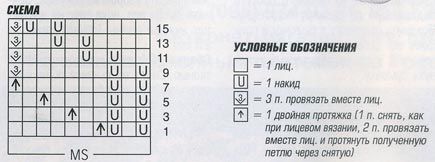
Knitting density, persons satin stitch: 30 stitches and 42 rows = 10 x 10 cm.
How to knit openwork baby socks.
On circular knitting needles, cast on 156 stitches and knit 2 circular stitches for the ruffle. purl P.
In the next roundabout. knit all loops in 3 stitches together (remove 1 stitch as in knitting, knit 2 stitches together and pull the resulting loop through the removed loop).
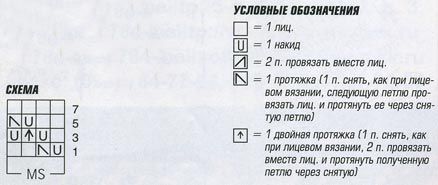
Distribute the remaining 52 stitches on 4 double needles (13 stitches on each needle) and knit 6 round stitches. elastic band and 1 circular p. facial loops.
Continue work openwork pattern.
After 8 cm from the elastic, transfer the first 2 stitches to the previous knitting needle and start knitting the heel along.
After the heel, continue working on 24 loops of the 2nd and 3rd needles - an openwork pattern, on the remaining loops - knits. satin stitch
After 15.5 cm from the middle of the heel, start knitting the toe, while decreasing 2 times in every 3rd circular row, 3 times in every 2nd circular row. and further in each circular r.
Nothing will warm your little one in cold weather like warm and soft socks created by caring mother with love and tenderness. Moreover, in this case, the mother certainly does not have to worry about their quality and convenience. To create such a cute children's item, all you need is two free evenings and a little patience.
So, do you want to please your little one with a unique heartfelt gift, and also be known as a needlewoman and jack-of-all-trades among other mothers? Then join our knitting master class children's socks knitted!
To work we will need:
- 50 g of light green threads;
- 50 g of white thread;
- 50 g mint-colored threads;
- set of 5 standard sock needles;
- a few extra knitting needles and pins.
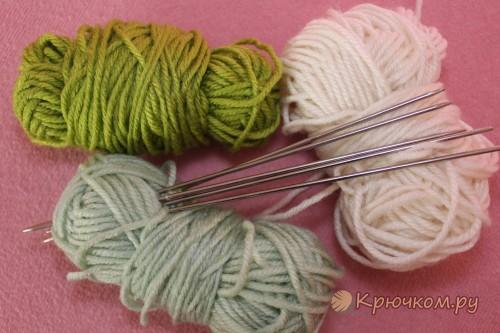
Description of the knitting process:
For a two-year-old baby, we hang 40 loops on two knitting needles folded together, without tightening them too tightly (then it will be difficult to knit and you will have to put in effort), but also without making them too frivolous, otherwise the edges of our socks will turn out sloppy.
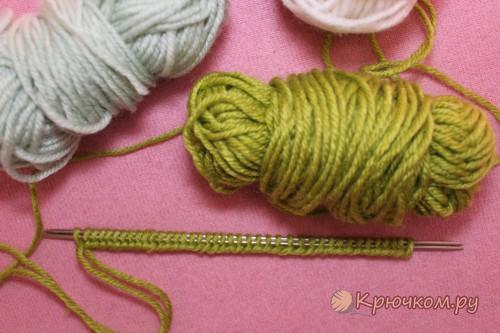
We will perform the first 15 rows with an ordinary 1x1 elastic band (1 p. front, 1 p. purl). When knitting the very first row after the cast-on edge, we simultaneously divide the cast-on stitches into 4 knitting needles - 10 for each. The remaining fifth needle will be exclusively knitting. IN in this case The technology involves knitting the product in the round, i.e. without turning it over.
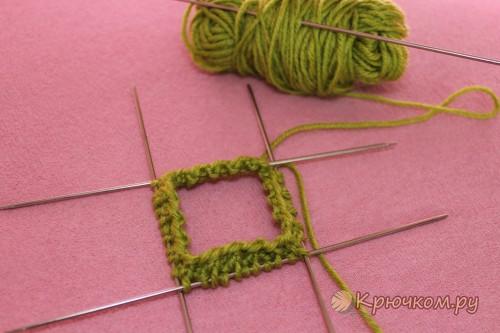
To repeat the ornamental combination of colors, as in the sample photographs, we perform the initial 7 rows of elastic with a light green thread, the next 5 rows with white and another 3 rows with mint-colored thread.
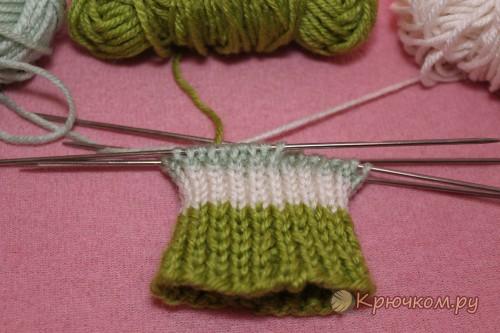
Having finished creating the elastic band, we begin to knit the fabric with facial loops, observing the following sequence of colors: 5 rows - white thread and 3 - mint-colored thread, as in the photo.
The number of rows in this part of the sock can be increased at your own discretion. The more you knit, the higher the top of the socks will be (thus, if necessary, you can easily knit even high knee socks using exactly the same pattern).
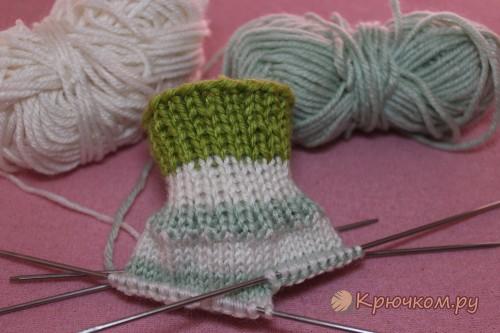
Shaping the instep and heel
Having completed work on the boot, we begin to create the instep with the heel. We knit the instep and heel with 20 loops. Temporarily unused loops can be transferred to a spare pin for a while or left on the knitting needles if this does not interfere with your work.
In order to form a rise, we will work on 20 loops, knitting 12 rows in a row with stockinette stitch (5 rows with white thread and 7 rows with light green thread). At the same time, it is important not to forget that the rise is no longer knitted in the round, but in the usual way - on two knitting needles. It should be said that while knitting an instep, it is better to constantly try the workpiece on a child’s leg, so that later the child does not feel discomfort, since the height of the instep is individual for each person, even a very small one.
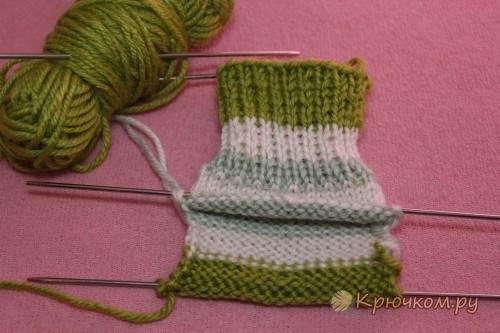
Having knitted the required number of rows of lifting, we move on to rounding the heel, which we will make completely light green.
To do this, we divide the 20 loops involved, with the help of which we created the rise, into three parts using auxiliary knitting needles as follows: 6 sts – 8 sts – 6 sts.
Next, we knit as follows: we knit all the loops from the first (6) and second (8) knitting needles, but at the same time we knit the eighth (last) loop from the second knitting needle together with the first loop from the third knitting needle. We leave the remaining 5 loops from the third knitting needle unknitted, turn the work inside out and knit 8 middle loops, while again we knit the eighth loop together with the first loop from the next knitting needle, and leave the remaining loops on it unknitted. That is, in fact, we knit the heel on the middle 8 loops, each time adding one loop from the adjacent knitting needle. We repeat this process until there are no stitches left on the side needles.
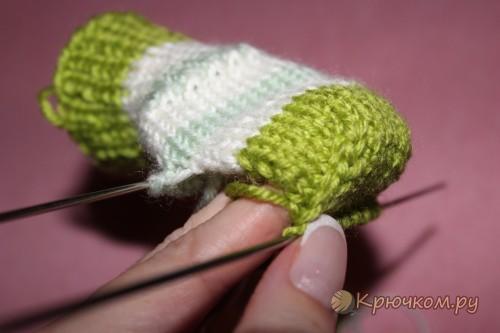
Shaping the foot and toe
Having finished the heel, we again return to circular knitting on 4 knitting needles. To do this, along the ascent line on both sides, we need to pick up 6 missing loops, so that in the end we again have 40 loops on our knitting needles.
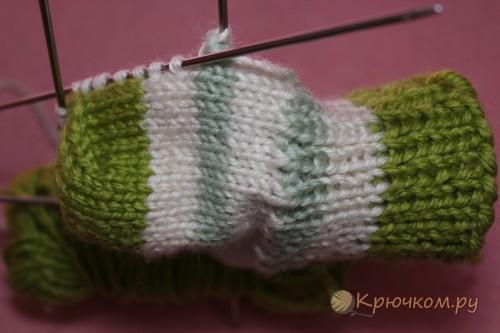
We spread these loops 10 on each of the knitting needles and then perform 5 rows with white thread, 3 rows with mint thread and again 5 rows with white thread. In this case, the number of knitted rows will depend on the length of the child’s foot.
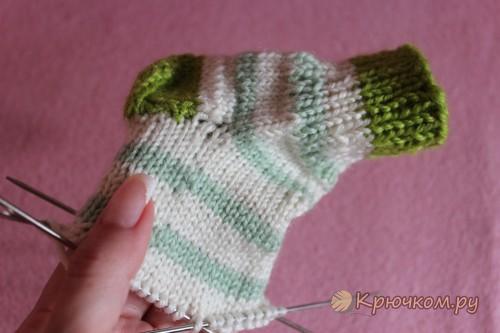
Having knitted the fabric of the required length, we proceed to forming the toe of the product. We knit it with light green threads. In order to ultimately get a uniform and neat narrowing, we will make a decrease after one row. For this purpose, we remove the first loop on each of the knitting needles, knit the next one after it and pull it through the removed loop, and knit the last two loops together, giving them an inclination to the right (we thread the knitting needle not from right to left, but vice versa - from left to right). Thus, during the work process, the number of loops on each of the four knitting needles should decrease in the following sequence: 10 sts – 8 sts – 6 sts – 4 sts – 2 sts – 1 st.
When we have only 4 loops left on all the knitting needles, we remove them with a thread, tighten them tightly, and secure the end on the wrong side with a needle.
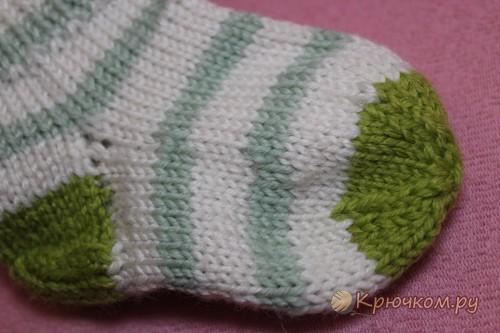
Now you can proceed to product design. In the socks shown in the photo, pom-poms were used for decoration, made according to the method also available on this site.
Before designing the product, the socks must be washed and steamed so that all the loops fit better and the yarn becomes softer and does not “bite” your baby.
We hope everything worked out for you.
Even loops for you.
Share your result with us and leave comments.




